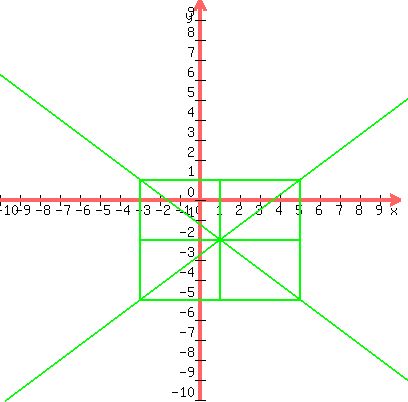16y² - 9x² + 18x + 64y - 89 = 0
That's a hyberbola because it has both x² and y² terms with opposite
signs when on the same side of the equation:
We have to get it to looking like this which opens upward and downward:
 -
-  = 1
or this, which opens downward or upward:
= 1
or this, which opens downward or upward:
 -
-  = 1
16y² - 9x² + 18x + 64y - 89 = 0
Get they y terms and the x terms together and the
constant on the right:
16y² + 64y - 9x² + 18x = 89
Factor the coefficient of y², which is 16, out of the first two terms.
Factor the coefficient of x², which is -9, out of the next two terms.
16(y² + 4y) - 9(x² - 2x) = 89
Multiply the coefficient of y, which is 4, by
= 1
16y² - 9x² + 18x + 64y - 89 = 0
Get they y terms and the x terms together and the
constant on the right:
16y² + 64y - 9x² + 18x = 89
Factor the coefficient of y², which is 16, out of the first two terms.
Factor the coefficient of x², which is -9, out of the next two terms.
16(y² + 4y) - 9(x² - 2x) = 89
Multiply the coefficient of y, which is 4, by  , getting 2.
Then square 2, getting +4, add +4 inside the first parentheses which
is multiplied by 16 which amounts to multiplying 16·4, so we add
16·4 to the right side:
Multiply the coefficient of x, which is -2, by
, getting 2.
Then square 2, getting +4, add +4 inside the first parentheses which
is multiplied by 16 which amounts to multiplying 16·4, so we add
16·4 to the right side:
Multiply the coefficient of x, which is -2, by  , getting -1.
Then square -1, getting +1, add +1 inside the second parentheses which
is multiplied by -9 which amounts to multiplying -9·1, so we add
-9·1 to the right side:
16(y² + 4y + 4) - 9(x² - 2x + 1) = 89 + 16·4 - 9·1
Factor the trinomials in the parentheses and do some work on the right
side.
16(y + 2)(y + 2) - 9(x - 1)(x - 1) = 89 + 64 - 9
Write the factorizations as the square of binomials and finish the
right side:
16(y + 2)² - 9(x - 1)² = 144
, getting -1.
Then square -1, getting +1, add +1 inside the second parentheses which
is multiplied by -9 which amounts to multiplying -9·1, so we add
-9·1 to the right side:
16(y² + 4y + 4) - 9(x² - 2x + 1) = 89 + 16·4 - 9·1
Factor the trinomials in the parentheses and do some work on the right
side.
16(y + 2)(y + 2) - 9(x - 1)(x - 1) = 89 + 64 - 9
Write the factorizations as the square of binomials and finish the
right side:
16(y + 2)² - 9(x - 1)² = 144
 -
-  =
= 
 -
-  = 1
This compares to:
= 1
This compares to:
 -
-  = 1
So it opens upward and downward.
h = 1, k = -2, a² = 9, so a = 3. b² = 16, so b = 4.
The center is (h,k) = (1,-2).
a = 3, so the transverse axis is 2·a or 6
b = 4, so the conjugate axis is 2·b or 8.
We draw the transverse axis vertically and the conjugate axis
horizontally, perpendicularly bisecting each other at the center (1,-2)
= 1
So it opens upward and downward.
h = 1, k = -2, a² = 9, so a = 3. b² = 16, so b = 4.
The center is (h,k) = (1,-2).
a = 3, so the transverse axis is 2·a or 6
b = 4, so the conjugate axis is 2·b or 8.
We draw the transverse axis vertically and the conjugate axis
horizontally, perpendicularly bisecting each other at the center (1,-2)
 Draw the defining rectangle around that cross, which is the rectangle
with horizontal and vertical sides with the ends of the transverse and
vertical axes bisecting the sides:
Draw the defining rectangle around that cross, which is the rectangle
with horizontal and vertical sides with the ends of the transverse and
vertical axes bisecting the sides:
 Draw and extend the diagonals of that rectangle:
Draw and extend the diagonals of that rectangle:
 Sketch in the hyperbola:
Sketch in the hyperbola:
 The equations of the asymptotes can be found use point-slope form:
y =
The equations of the asymptotes can be found use point-slope form:
y =  x -
x -  and
y =
and
y =  x -
x -  The foci (or focal points) are c units on each side of the center
inside the two branches of the hyperbola, where
c² = a² + b²
c² = 3² + 4²
c² = 9 + 16
c² = 25
c = 5
So they are 5 units above and below the center and are the
two points inside the two branches (1,-7) and (1,3).
The foci (or focal points) are c units on each side of the center
inside the two branches of the hyperbola, where
c² = a² + b²
c² = 3² + 4²
c² = 9 + 16
c² = 25
c = 5
So they are 5 units above and below the center and are the
two points inside the two branches (1,-7) and (1,3).
 Edwin
Edwin